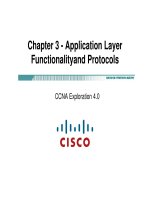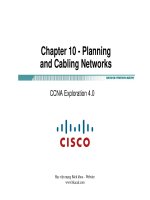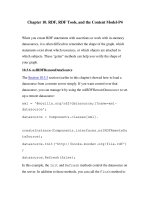Chapter 10 - Link-State Routing Protocols CCNA ppt
Bạn đang xem bản rút gọn của tài liệu. Xem và tải ngay bản đầy đủ của tài liệu tại đây (811.85 KB, 28 trang )
Chapter 10 - Link-State Routing
Protocols
CCNA Exploration 4.0
1
Objectives
•
•
Describe the basic features & concepts of link-state
routing protocols.
List the benefits and requirements of link-state routing
protocols.
Học viện mạng Bach Khoa - Website: www.bkacad.com
2
Introduction
Học viện mạng Bach Khoa - Website: www.bkacad.com
3
Link-State Routing
Học viện mạng Bach Khoa - Website: www.bkacad.com
4
Link-State Routing
•
Link state routing protocols
– Also known as shortest path first algorithms.
– These protocols built around Dijkstra’s SPF.
Học viện mạng Bach Khoa - Website: www.bkacad.com
5
Link-State Routing
•
Dikjstra’s algorithm also known as the Shortest Path First
(SPF) algorithm. This algorithm accumulates costs along
each path, from source to destination.
Học viện mạng Bach Khoa - Website: www.bkacad.com
6
Link-State Routing
•
The shortest path to a destination is not necessarily the
path with the least number of hops.
Học viện mạng Bach Khoa - Website: www.bkacad.com
7
Link-State Routing
•
How routers using Link State Routing Protocols reach convergence
– Each routers learns about its own directly connected networks
– Link state routers exchange hello packet to “meet” other directly connected
link state routers.
– Each router builds its own Link State Packet (LSP) which includes
information about neighbors such as neighbor ID, link type, & bandwidth.
– After the LSP is created the router floods it to all neighbors who then store
the information and then immediately forward it until all routers have the
same information.
– Once all the routers have received all the LSPs, the routers then construct
a topological map of the network which is used to determine the best
routes to a destination.
Học viện mạng Bach Khoa - Website: www.bkacad.com
8
Link-State Routing
•
•
•
Directly Connected Networks.
Link: this is an interface on a router.
Link state: this is the information about the state of the links.
Học viện mạng Bach Khoa - Website: www.bkacad.com
9
Link-State Routing
•
Routers with link-state routing protocols use a Hello
protocol to discover any neighbors on its links. A neighbor
is any other router that is enabled with the same link-state
routing protocol.
Học viện mạng Bach Khoa - Website: www.bkacad.com
10
Link-State Routing
Sending Hello Packets to Neighbors
• Connected interfaces that are using
the same link state routing protocols
will exchange hello packets.
• Once routers learn it has neighbors
they form an adjacency
– 2 adjacent neighbors will
exchange hello packets.
– These packets will serve as a
keep alive function.
Học viện mạng Bach Khoa - Website: www.bkacad.com
11
Link-State Routing
Building the
Link State Packet
• Each router builds its
own Link State Packet
(LSP)
• Contents of LSP:
– State of each
directly connected
link
– Includes
information about
neighbors such as
neighbor ID, link
type, & bandwidth.
Học viện mạng Bach Khoa - Website: www.bkacad.com
12
Link-State Routing
Flooding LSPs to Neighbors
• Once LSP are created they are forwarded out to neighbors.
– After receiving the LSP the neighbor continues to forward it
throughout routing area.
Học viện mạng Bach Khoa - Website: www.bkacad.com
13
Link-State Routing
•
LSPs are sent out under the following conditions
– Initial router start up or routing process.
– When there is a change in topology.
Học viện mạng Bach Khoa - Website: www.bkacad.com
14
Link-State Routing
Constructing a link state data base
• Routers use a database to construct a topology map of the
network.
Học viện mạng Bach Khoa - Website: www.bkacad.com
15
Link-State Routing
Học viện mạng Bach Khoa - Website: www.bkacad.com
16
Link-State Routing
Shortest Path First (SPF) Tree
• Building a portion of the
SPF tree.
• Process begins by examining
R2’s LSP information.
• R1 ignores 1st LSP: R1
already knows it’s connected
to R2.
Học viện mạng Bach Khoa - Website: www.bkacad.com
17
Link-State Routing
•
•
Building a portion of the
SPF tree
R1 uses 2nd LSP
Reason: R1 can create
a link from R2 to R5.
This information is added
to R1’s SPF tree.
Học viện mạng Bach Khoa - Website: www.bkacad.com
18
Link-State Routing
•
Building a portion of the SPF tree
R1 uses 3rd LSP
Reason: R1 learns that R2
is connected to 10.5.0.0/16.
This link is added to R1’s
SPF tree.
Học viện mạng Bach Khoa - Website: www.bkacad.com
19
Link-State Routing
•
Determining the shortest
path
– The shortest path to a
destination determined
by adding the costs &
finding the lowest cost.
Học viện mạng Bach Khoa - Website: www.bkacad.com
20
Link-State Routing
•
Once the SPF algorithm has
determined the shortest path
routes, these routes are
placed in the routing table.
Học viện mạng Bach Khoa - Website: www.bkacad.com
21
Implementing
Link-State Routing Protocols
Học viện mạng Bach Khoa - Website: www.bkacad.com
22
Advantages of Link-State Routing Protocols
Routing
protocol
Router can
Builds
independent
Topological ly determine Convergence
map
the shortest
path to
every
network.
Event driven
routing
updates
Use
of
LSP
Distance
vector
No
No
Slow
Generally
No
No
Link State
Yes
Yes
Fast
Yes
Yes
Học viện mạng Bach Khoa - Website: www.bkacad.com
23
Requirements for Link-State Routing Protocols
•
•
•
Memory requirements
– Typically link state routing protocols use more memory.
Processing Requirements
– More CPU processing is required of link state routing
protocols.
Bandwidth Requirements
– Initial startup of link state routing protocols can consume lots
of bandwidth.
Học viện mạng Bach Khoa - Website: www.bkacad.com
24
Areas in Link-State Routing Protocols
• Modern LSR protocols are designed to minimize the effects on
memory, CPU, and bandwidth. Multiple areas can reduce the size of
the link-state databases. It limits the amount of link-state information
flooding in a routing domain and send LSPs only to those routers that
need them.
Học viện mạng Bach Khoa - Website: www.bkacad.com
25









